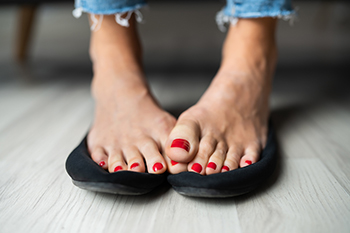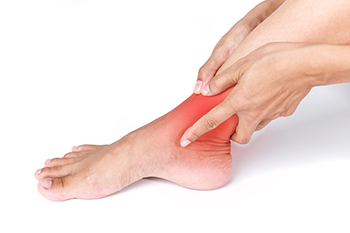Connect With Us
Blog
Items filtered by date: June 2023
How Do Ankle Sprains Happen?

Ankle sprains generally happen due to over-stretched ligaments on the outside of the ankle. The ligaments connect the bones and joints to each other and provide stability and balance to the body. Common causes of ankle sprains can consist of suddenly twisting the ankle from unexpectedly stepping off a curb or walking on uneven surfaces. Existing foot injuries may also lead to a sprained ankle, or it may happen to patients born with weak ankles. People can experience symptoms such as swelling and bruising, and walking can be difficult. A diagnosis is often performed that can rule out a broken ankle. Once the sprained ankle is confirmed, treatment can begin. This generally consists of refraining from bearing weight on it for several weeks, in addition to wearing an elastic wrap that can provide stability. If you have sprained your ankle, it is suggested that you confer with a podiatrist who can guide you toward the correct treatment method.
Although ankle sprains are common, they aren’t always minor injuries. If you need your ankle injury looked at, contact Emil Babayev, DPM from New York. Our doctor can provide the care you need to keep you pain-free and on your feet.
How Does an Ankle Sprain Occur?
Ankle sprains are the result of a tear in the ligaments within the ankle. These injuries may happen when you make a rapid shifting movement while your foot is planted. A less common way to sprain your ankle is when your ankle rolls inward while your foot turns outward.
What Are the Symptoms?
- Pain at the sight of the tear
- Bruising/Swelling
- Ankle area is tender to touch
- In severe cases, may hear/feel something tear
- Skin discoloration
Preventing a Sprain
- Wearing appropriate shoes for the occasion
- Stretching before exercises and sports
- Knowing your limits
Treatment of a Sprain
In many cases, the RICE method (Rest, Ice, Compression, and Elevate) is used to treat ankle sprains. However, you should see a podiatrist to see which treatment option would work best with your injury. In severe cases, surgery may be required.
It is important to ask your doctor about rehab options after you receive treatment for your injury. Stretching, strength training, and balance exercises may help the ankle heal while also preventing further injury.
If you have any questions, please feel free to contact our offices located in Midwood and Kensington in Brooklyn, NY . We offer the newest diagnostic and treatment technologies for all your foot care needs.
Which Type of Hyperhidrosis Do I Have?

Hyperhidrosis is defined as excessive sweating. Plantar hyperhidrosis affects the feet and can cause discomfort and embarrassment. There are approximately 125,000 sweat glands in each foot and they can work overtime in people who are afflicted with this condition. Hyperhidrosis affects approximately five percent of people nationwide and typically males are targeted more than females. There are two categories of hyperhidrosis. Excessive sweating that begins in childhood and continues into adulthood is known as primary or focal hyperhidrosis. When larger body areas are affected, this can be referred to as secondary hyperhidrosis which might be a side effect of taking certain medications. Suppose you sweat excessively beyond the average causes of running or exercising. In that case, it is suggested that you consult with a podiatrist who can determine which type of hyperhidrosis you have and offer you relief methods.
If you are suffering from hyperhidrosis contact Emil Babayev, DPM of New York. Our doctor can provide the care you need to attend to all of your foot and ankle needs.
Hyperhidrosis of the Feet
Hyperhidrosis is a rare disorder that can cause people to have excessive sweating of their feet. This can usually occur all on its own without rigorous activity involved. People who suffer from hyperhidrosis may also experience sweaty palms.
Although it is said that sweating is a healthy process meant to cool down the body temperature and to maintain a proper internal temperature, hyperhidrosis may prove to be a huge hindrance on a person’s everyday life.
Plantar hyperhidrosis is considered to be the main form of hyperhidrosis. Secondary hyperhidrosis can refer to sweating that occurs in areas other than the feet or hands and armpits. Often this may be a sign of it being related to another medical condition such as menopause, hyperthyroidism and even Parkinson’s disease.
In order to alleviate this condition, it is important to see your doctor so that they may prescribe the necessary medications so that you can begin to live a normal life again. If this is left untreated, it is said that it will persist throughout an individual’s life.
A last resort approach would be surgery, but it is best to speak with your doctor to find out what may be the best treatment for you.
If you have any questions please feel free to contact our offices located in Midwood and Kensington in Brooklyn, NY . We offer the newest diagnostic and treatment technologies for all your foot and ankle needs.
Plantar Warts Can Be Treated!
Dealing With Cuts and Other Foot Wounds

The skin, which is the largest organ in the body, consists of layers called epidermis, dermis, and hypodermis. It serves as the body’s first barrier to pathogens, ultraviolet light, chemicals, and injury. When the skin is grazed, its outer layer is damaged. When the skin is cut, depending on the depth and size of the wound, two or more layers may be injured. It is important to take certain measures when faced with wounds on the feet and ankles. First, wash your hands before touching the wound. Next, try to stop the bleeding by placing a sterile pad on the wound and applying pressure. If bleeding continues, it is important to get medical help immediately. Clean the wound and try to remove dirt or gravel particles, wiping from the center of the wound outward. Avoid using cotton balls or other materials that can leave fibers inside the wound. Then cover the wound with a sterile bandage. In severe cases, or if the wound on your foot shows signs of infection, it is suggested that you visit a podiatrist who can safely and properly treat it.
Wound care is an important part in dealing with diabetes. If you have diabetes and a foot wound or would like more information about wound care for diabetics, consult with Emil Babayev, DPM from New York. Our doctor will assess your condition and provide you with quality foot and ankle treatment.
What Is Wound Care?
Wound care is the practice of taking proper care of a wound. This can range from the smallest to the largest of wounds. While everyone can benefit from proper wound care, it is much more important for diabetics. Diabetics often suffer from poor blood circulation which causes wounds to heal much slower than they would in a non-diabetic.
What Is the Importance of Wound Care?
While it may not seem apparent with small ulcers on the foot, for diabetics, any size ulcer can become infected. Diabetics often also suffer from neuropathy, or nerve loss. This means they might not even feel when they have an ulcer on their foot. If the wound becomes severely infected, amputation may be necessary. Therefore, it is of the upmost importance to properly care for any and all foot wounds.
How to Care for Wounds
The best way to care for foot wounds is to prevent them. For diabetics, this means daily inspections of the feet for any signs of abnormalities or ulcers. It is also recommended to see a podiatrist several times a year for a foot inspection. If you do have an ulcer, run the wound under water to clear dirt from the wound; then apply antibiotic ointment to the wound and cover with a bandage. Bandages should be changed daily and keeping pressure off the wound is smart. It is advised to see a podiatrist, who can keep an eye on it.
If you have any questions, please feel free to contact our offices located in Midwood and Kensington in Brooklyn, NY . We offer the newest diagnostic and treatment technologies for all your foot care needs.
What Causes Foot Pain?

An unfortunate reality that many Americans face every day is that foot pain can be quite a disruption to everyday life. Many patients of podiatrists often ask what exactly causes foot pain. The answer is that there are a multitude of different potential causes of foot pain, and so the precise cause is very specific to the individual patient. For example, being obese can cause foot pain because of the extra weight that is exerted on the feet. Additionally, wearing shoes that are not supportive, such as flip flops or high heels, can trigger sensations of pain in the feet. It is possible that a person may also be experiencing foot pain due to an underlying foot condition, such as plantar fasciitis or heel spurs. If you are someone that is experiencing foot pain, it is suggested that you contact a podiatrist today who can determine what the cause is, and offer correct treatment solutions.
Foot Pain
Foot pain can be extremely painful and debilitating. If you have a foot pain, consult with Emil Babayev, DPM from New York. Our doctor will assess your condition and provide you with quality foot and ankle treatment.
Causes
Foot pain is a very broad condition that could be caused by one or more ailments. The most common include:
- Bunions
- Hammertoes
- Plantar Fasciitis
- Bone Spurs
- Corns
- Tarsal Tunnel Syndrome
- Ingrown Toenails
- Arthritis (such as Gout, Rheumatoid, and Osteoarthritis)
- Flat Feet
- Injury (from stress fractures, broken toe, foot, ankle, Achilles tendon ruptures, and sprains)
- And more
Diagnosis
To figure out the cause of foot pain, podiatrists utilize several different methods. This can range from simple visual inspections and sensation tests to X-rays and MRI scans. Prior medical history, family medical history, and any recent physical traumatic events will all be taken into consideration for a proper diagnosis.
Treatment
Treatment depends upon the cause of the foot pain. Whether it is resting, staying off the foot, or having surgery; podiatrists have a number of treatment options available for foot pain.
If you have any questions, please feel free to contact our offices located in Midwood and Kensington in Brooklyn, NY . We offer the newest diagnostic and treatment technologies for all your foot care needs.

